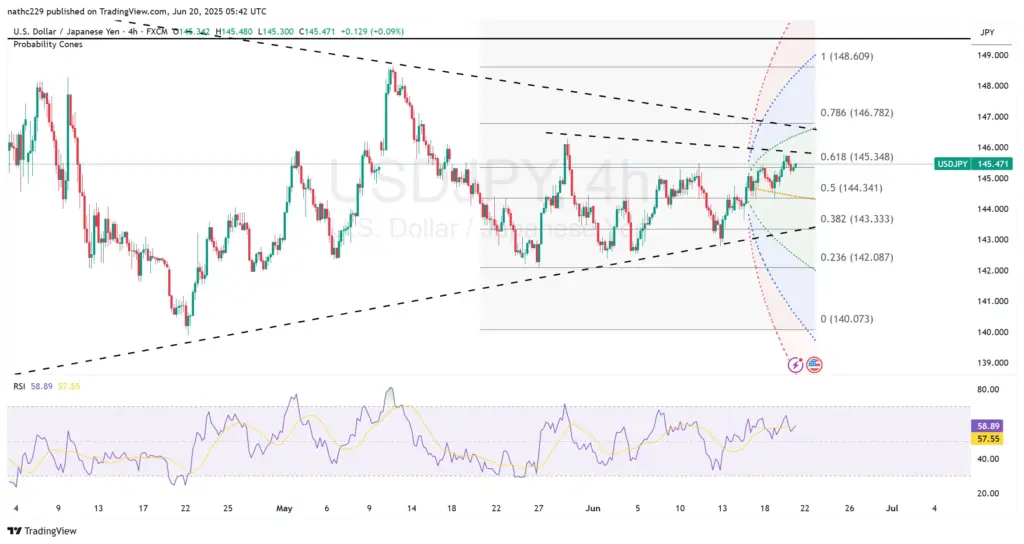USD/JPY Holds Narrow Range Amid Technical Uncertainty and Geopolitical Support

USD/JPY is trading within a narrowly defined Ichimoku cloud range during Asian trading hours, indicating a cautious market stance amid mixed signals from technical indicators, geopolitical concerns, and central bank policies. This consolidation occurs as traders assess the potential impact of significant option expiries and forthcoming economic data.
Technical Outlook
USD/JPY traded between 145.13 and 145.55 in Asian trading, characterized by subdued volatility within a thin daily Ichimoku cloud stretching from 144.88 to 145.55. The sideways movement highlights current market indecision, with investors awaiting clearer directional cues.
Previous attempts to break above resistance at 145.77 were met with limited follow-through due to low holiday liquidity, emphasizing the significance of robust liquidity conditions for sustained directional moves.
Key support remains at the hourly ascending Ichimoku cloud between 144.88 and 144.89, reinforced by the rising 100-hour MA (144.92) and 200-hour MA (144.61). The resilience of these technical levels is crucial for maintaining current USD/JPY stability.
Significant resistance zones are marked by psychological levels at 145.00 and 146.00, heavily influenced by substantial option expiries. These barriers serve as containment points, potentially capping short-term volatility and directing market attention to these pivotal technical levels.
Momentum indicators currently exhibit neutral tendencies, reflecting uncertainty within the narrow trading range and underscoring the importance of monitoring potential breakout scenarios.
Geopolitical Factors and Market Sentiment
The sustained geopolitical tensions, notably in the Middle East, continue to underpin the U.S. dollar’s relative strength, particularly against traditionally risk-sensitive currencies like the yen. The dollar's safe-haven status remains a key factor influencing market sentiment, particularly in times of heightened uncertainty.
Minimal transactional activity at the Gotobi Tokyo fix further emphasizes cautious investor positioning amid ongoing geopolitical risks. Reduced market flows typically indicate traders' reluctance to commit fully to directional bets, especially ahead of significant economic releases and geopolitical developments.
Central Bank Policy Impacts
Recent central bank announcements have mostly aligned with market expectations, facilitating stability across various yen crosses. The Bank of Japan's consistently dovish stance contrasts subtly with the more balanced positions of other major central banks, influencing yen dynamics broadly.
EUR/JPY trading stability, despite ECB dovish remarks, and GBP/JPY’s limited movement following the BoE rate decision highlight market equilibrium shaped by central bank actions and option expiries.
Economic Data and Future Indicators
The imminent release of Japanese economic indicators, specifically April machinery orders and May trade balance figures, will be crucial for assessing Japan's economic resilience. Traders must remain vigilant, as unexpected data outcomes could sharply influence yen sentiment and USD/JPY volatility.
Risk Management and Strategic Considerations
Downside risks for USD/JPY include a significant escalation in geopolitical tensions or unexpectedly weak economic data from Japan, potentially sparking increased yen demand. Conversely, any breakout above established resistance could significantly enhance bullish sentiment.
Traders should adopt stringent risk management, closely monitoring price action around pivotal technical levels and economic data releases. Strategic positioning should incorporate protective stop-loss mechanisms to mitigate potential volatility stemming from geopolitical uncertainties and data surprises.
Conclusion
USD/JPY's current consolidation within the Ichimoku cloud underscores market uncertainty and highlights potential breakout opportunities. Traders must diligently monitor geopolitical developments, central bank communications, and forthcoming economic indicators to effectively navigate this cautious trading environment.
